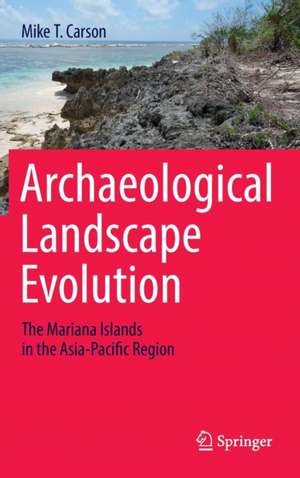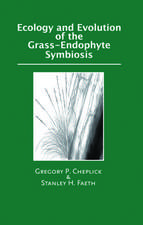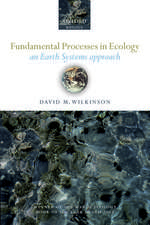Archaeological Landscape Evolution: The Mariana Islands in the Asia-Pacific Region
Autor Mike T. Carsonen Limba Engleză Hardback – 27 iun 2016
Thisbook guides readers on a journey through the concurrent processes of change inan integrated natural-cultural history of a landscape. While outlining the general principles forglobal application, a richly illustrated case is offered through the MarianaIslands in the northwest tropical Pacific and furthermore situated in a largerAsia-Pacific context for a full comprehension of landscape evolution atvariable scales. The author examines whathappened during the first time when human beings encountered the world’s RemoteOceanic environment in the Mariana Islands about 3500 years ago, followed by acontinuous sequence of changing sea level, climate, water resources, forestcomposition, human population growth, and social dynamics. This book provides a high-resolution andlong-term view of the complexities of landscape evolution that affect all of ustoday.
| Toate formatele și edițiile | Preț | Express |
|---|---|---|
| Paperback (1) | 389.70 lei 6-8 săpt. | |
| Springer International Publishing – 30 mai 2018 | 389.70 lei 6-8 săpt. | |
| Hardback (1) | 397.16 lei 6-8 săpt. | |
| Springer International Publishing – 27 iun 2016 | 397.16 lei 6-8 săpt. |
Preț: 397.16 lei
Nou
Puncte Express: 596
Preț estimativ în valută:
75.100€ • 78.40$ • 63.42£
75.100€ • 78.40$ • 63.42£
Carte tipărită la comandă
Livrare economică 26 martie-09 aprilie
Preluare comenzi: 021 569.72.76
Specificații
ISBN-13: 9783319313993
ISBN-10: 3319313991
Pagini: 236
Ilustrații: XIII, 307 p. 113 illus.
Dimensiuni: 155 x 235 x 19 mm
Greutate: 0.63 kg
Ediția:1st ed. 2016
Editura: Springer International Publishing
Colecția Springer
Locul publicării:Cham, Switzerland
ISBN-10: 3319313991
Pagini: 236
Ilustrații: XIII, 307 p. 113 illus.
Dimensiuni: 155 x 235 x 19 mm
Greutate: 0.63 kg
Ediția:1st ed. 2016
Editura: Springer International Publishing
Colecția Springer
Locul publicării:Cham, Switzerland
Cuprins
Part one: Parameters ofstudy
Chapter 1: Landscapeevolution as natural-cultural history
Evolution of an inhabitedlandscape
The Marianas landscape as amodel system
Structure and content ofthis book
References
Chapter 2: Globalapplicability of landscape evolution
Coastal China
California
Hawaiian Islands
Mariana Islands
References
Chapter 3: Environmentalsetting and dynamics
Geological structure
Sea-level history
Coastal geomorphology
Slope erosion-depositionpatterns
Soil formation
Plant and animal communities
Climate and weather
Water sources
References
Chapter 4: Marianasarchaeology in local and regional perspectives
Marianas settlement inAsia-Pacific context
Foundations of Chamorroheritage
References
Chapter 5: Coordinating perspectivesof the past
Historical perspectives
Linguistics
Human biology and genetics
Faunal records
Botanical records
References
Chapter 6: Range ofarchaeological material culture
Artefacts
Midden
Structural features
Rock art
Caves
Landscapes
References
Part Two: Chronologicalsequence
Chapter 7: Building anarchaeological chronology
Use of radiocarbon dating
Marianas chronologicaloutline References
Chapter 8: 1500–1100 B.C.,initial settlement
Site inventory and dating
Landforms
Resource zones
Material culture
Regional context
References
Chapter 9: 1100–700 B.C.,changing coastlines
Site inventory and dating
Landforms
Resource zones
Material culture Regional context
References
Chapter 10: 700 B.C.–A.D. 1,broadened horizons
Site inventory and dating
Landforms
Resource zones
Material culture
Regional context
References
Chapter 11: A.D. 1–500,temporary stability
Site inventory and dating
Landforms
Resource zones
Material culture Regional context
References
Chapter 12: A.D. 500–1000,sustained use of coastal and inland zones
Site inventory and dating
Landforms
Resource zones
Material culture
Regional context
References
Chapter 13: A.D. 1000–1700,a sea of islands and monuments
Site inventory and dating
Landforms
Resource zones
Material culture
Regional context
References
Chapter 14: A.D.1700–Present, living with colonialism and globalisation
Site inventory and dating
Landforms
Resource zones
Material culture
Regional context
References
Part Three: Pursuingresearch questions
Chapter 15: First inhabitingof a landscape
Human migration into a newlandscape
Initial inhabiting of alandscape
Origins of landscapeevolution
References
Chapter 16: Long-termhuman-environment relations
Geology and landforms
Climate
Sea level and coastalecology
Water sources
Plant and animal populations
Patterns of residence andresource use
Material culture
Continuity and change
References
Chapter 17: Futuredirections
Chapter 1: Landscapeevolution as natural-cultural history
Evolution of an inhabitedlandscape
The Marianas landscape as amodel system
Structure and content ofthis book
References
Chapter 2: Globalapplicability of landscape evolution
Coastal China
California
Hawaiian Islands
Mariana Islands
References
Chapter 3: Environmentalsetting and dynamics
Geological structure
Sea-level history
Coastal geomorphology
Slope erosion-depositionpatterns
Soil formation
Plant and animal communities
Climate and weather
Water sources
References
Chapter 4: Marianasarchaeology in local and regional perspectives
Marianas settlement inAsia-Pacific context
Foundations of Chamorroheritage
References
Chapter 5: Coordinating perspectivesof the past
Historical perspectives
Linguistics
Human biology and genetics
Faunal records
Botanical records
References
Chapter 6: Range ofarchaeological material culture
Artefacts
Midden
Structural features
Rock art
Caves
Landscapes
References
Part Two: Chronologicalsequence
Chapter 7: Building anarchaeological chronology
Use of radiocarbon dating
Marianas chronologicaloutline References
Chapter 8: 1500–1100 B.C.,initial settlement
Site inventory and dating
Landforms
Resource zones
Material culture
Regional context
References
Chapter 9: 1100–700 B.C.,changing coastlines
Site inventory and dating
Landforms
Resource zones
Material culture Regional context
References
Chapter 10: 700 B.C.–A.D. 1,broadened horizons
Site inventory and dating
Landforms
Resource zones
Material culture
Regional context
References
Chapter 11: A.D. 1–500,temporary stability
Site inventory and dating
Landforms
Resource zones
Material culture Regional context
References
Chapter 12: A.D. 500–1000,sustained use of coastal and inland zones
Site inventory and dating
Landforms
Resource zones
Material culture
Regional context
References
Chapter 13: A.D. 1000–1700,a sea of islands and monuments
Site inventory and dating
Landforms
Resource zones
Material culture
Regional context
References
Chapter 14: A.D.1700–Present, living with colonialism and globalisation
Site inventory and dating
Landforms
Resource zones
Material culture
Regional context
References
Part Three: Pursuingresearch questions
Chapter 15: First inhabitingof a landscape
Human migration into a newlandscape
Initial inhabiting of alandscape
Origins of landscapeevolution
References
Chapter 16: Long-termhuman-environment relations
Geology and landforms
Climate
Sea level and coastalecology
Water sources
Plant and animal populations
Patterns of residence andresource use
Material culture
Continuity and change
References
Chapter 17: Futuredirections
Notă biografică
Mike T. Carson (Ph.D. inAnthropology, University of Hawaii, 2002) investigates archaeological andpalaeo-landscapes throughout the Asia-Pacific region. He currently is Associate Professor ofArchaeology at the Richard F. Taitano Micronesian Area Research Center (MARC),University of Guam, and he is co-editor of AsianPerspectives: The Journal of Archaeology for Asia and the Pacific,published by University of Hawaii Press.
Caracteristici
particularly high-resolution and long-term view of the complexities of
landscape evolution
Shows how archaeologyis uniquely suited to provide substantive case studies on how people haverelated with their changing environments and landscapes over hundreds or eventhousands of years
Explores thequestion: What can we as human beings learn about our role in shaping ourlandscapes and being shaped by them
Includes supplementary material: sn.pub/extras
landscape evolution
Shows how archaeologyis uniquely suited to provide substantive case studies on how people haverelated with their changing environments and landscapes over hundreds or eventhousands of years
Explores thequestion: What can we as human beings learn about our role in shaping ourlandscapes and being shaped by them
Includes supplementary material: sn.pub/extras
















